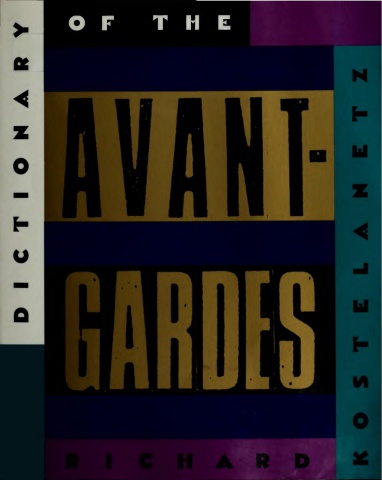Richard Kostelanetz: Dictionary of the Avant-Gardes (1993–)
Filed under book | Tags: · abstract art, aesthetics, art, art criticism, art history, art theory, avant-garde, dance, electroacoustic music, electronic music, experimental film, film, literature, mail art, music, music history, painting, performance art, poetry, radio art, sculpture, theatre, video, video art, visual poetry

“This book elucidates, celebrates, enumerates, and sometimes obliterates achievers and achievements in the avant-garde arts. Although it runs from A to Z, it could as easily have been written from Z to A (or in any other order you might imagine) and may be read from front to back, back to front, or point to point. It is opinionated, as all good dictionaries should be, but it is also inclusive, because there can never be just one avant-garde.
Blake • Rimbaud • Apollinaire • Stein • Cage • Lichtenstein • Tatlin • Keaton • Captain Beefheart • Hologram • Text-Sound Texts • Strobe Light • Grotowski • Soho • Micropress • Electronic Music • Reinhardt • Pound • Performance • Postmodern • Duchamp • Fuller • Oldenberg • Paik • Armory Show • Reich • Cunningham • Copy Culture • Pattern Poetry • Bread and Puppet Theatre” (from the back cover)
With contributions by Richard Carlin, Geof Huth, Gerald Janecek, Katy Matheson, H.R. Brittain, John Robert Colombo, Ulrike Michal Dorda, Charles Doria, and Robert Haller.
Publisher A Capella Books, an imprint of Chicago Review Press, 1993
ISBN 1556522029
246 pages
PDF
2nd edition (2000, 47 MB, added on 2020-3-18)
New additions (2011) selected for Soanyway by Derek Horton (HTML)
Thomas Harrison: 1910: The Emancipation of Dissonance (1996)
Filed under book | Tags: · 1910s, aesthetics, art, art history, avant-garde, expressionism, literature, music, music history, painting, philosophy, sociology

The year 1910 marks an astonishing, and largely unrecognized, juncture in Western history. In this perceptive interdisciplinary analysis, Thomas Harrison addresses the extraordinary intellectual achievement of the time. Focusing on the cultural climate of Middle Europe and paying particular attention to the life and work of Carlo Michelstaedter, he deftly portrays the reciprocal implications of different discourses—philosophy, literature, sociology, music, and painting. His beautifully balanced and deeply informed study provides a new, wider, and more ambitious definition of expressionism and shows the significance of this movement in shaping the artistic and intellectual mood of the age.
1910 probes the recurrent themes and obsessions in the work of intellectuals as diverse as Egon Schiele, Georg Trakl, Vasily Kandinsky, Georg Lukàcs, Georg Simmel, Dino Campana, and Arnold Schoenberg. Together with Michelstaedter, who committed suicide in 1910 at the age of 23, these thinkers shared the essential concerns of expressionism: a sense of irresolvable conflict in human existence, the philosophical status of death, and a quest for the nature of human subjectivity. Expressionism, Harrison argues provocatively, was a last, desperate attempt by the intelligentsia to defend some of the most venerable assumptions of European culture. This ideological desperation, he claims, was more than a spiritual prelude to World War I: it was an unheeded, prophetic critique.
Publisher University of California Press, 1996
ISBN 0520200438, 9780520200432
264 pages
Reviews (Martino Marazzi; Tyrus Miller; Daniela Bini; Christopher Hailey; Richard Mattin; Dennis Sexsmith)
Review (Laura A. McLary, Monatshefte)
Review (Thomas Kovach, Austrian History Yearbook)
Review (Marco Codebo, Carte Italiane)
Wikipedia
PDF (some images are missing)
View online (HTML, with images)
Joanna Demers: Listening Through the Noise: The Aesthetics of Experimental Electronic Music (2010)
Filed under book | Tags: · aesthetics, electronic music, experimental music, listening, music, music history, noise, sound recording

“Contemporary electronic music has splintered into a dizzying assortment of genres and subgenres, communities and subcultures. Given the ideological differences among academic, popular and avant-garde electronic musicians, is it possible to derive an aesthetic theory that accounts for this variety? And is there even a place for aesthetics in twenty-first-century culture?
Listening through the Noise explores genres ranging from techno to electroacoustic music, from glitch to drone music, and from dub to drones, and maintains that culturally and historically informed aesthetic theory is not only possible but indispensable for understanding electronic music. The abilities of electronic music to use preexisting sounds and to create new sounds are widely known. Author Joanna Demers proceeds from this starting point to consider how electronic music is changing the way we listen not only to music, but to sound itself. The common trait among all variants of recent experimental electronic music is a concern with whether sound, in itself, bears meaning. The use in recent works of previously undesirable materials like noise, field recordings, and extremely quiet sounds has contributed to electronic music’s destruction of the “musical frame,” the conventions that used to set apart music from the outside world. In the void created by the disappearance of the musical frame, different philosophies for listening have emerged. Some electronic music genres insist upon the inscrutability and abstraction of sound. Others maintain that sound functions as a sign pointing to concepts or places beyond the work. But all share an approach towards listening that departs fundamentally from the expectations that have governed music listening in the West for the previous five centuries.”
Publisher Oxford University Press, 2010
ISBN 0195387651, 9780195387650
248 pages
PDF (updated on 2012-8-3)
Comment (1)
